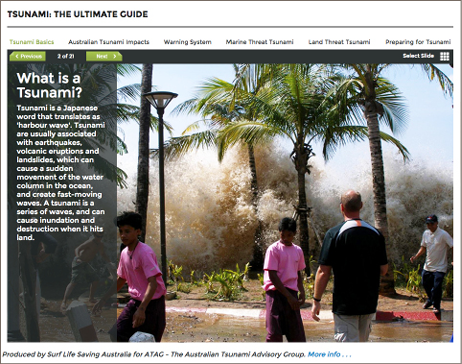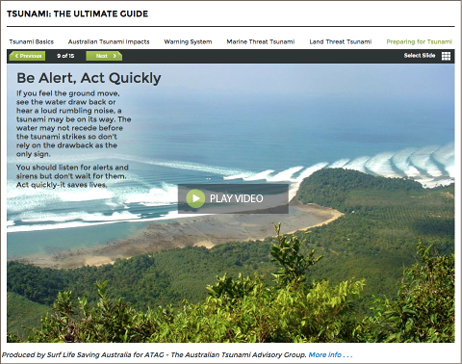
Sarah Anderson, Public Safety Project Coordinator, Surf Life Saving Australia
Surf Life Saving Australia (SLSA) has been recognised nationally at the 2014 Resilient Australia Awards in Canberra for the online resource Tsunami: The Ultimate Guide. The resource was produced in collaboration with the Australian Tsunami Advisory Group (ATAG) and achieved a Highly Commended Award in the Projects of National Significance category.
SLSA President Graham Ford said ‘This is a proud achievement for Surf Life Saving Australia. To be recognised nationally among so many high calibre and worthy projects is a credit to the hard work put in by the team at SLSA. Our key focus is always to create a safer environment for all Australians.’
Australia experiences a tsunami once every four years, on average. According to the Bureau of Meteorology, there have been more than 50 tsunami events in Australia since 1788. Many people aren’t aware that Australia experiences tsunami events. In fact, we are regularly affected by marine threat tsunami, which can cause dangerous rips, waves and strong currents.
ATAG faces a challenge to educate the public about the low-frequency, high-impact tsunami threat, the warning system, and where to find accurate information. This task is complicated by the Pacific Tsunami Warning Centre in Hawaii (which also provides advice following tsunamigenic events) listing countries that may be affected including Australia. Their messages may not align with the Joint Australian Tsunami Warning Centre (JATWC) warnings. This has led to past confusion in the public and media.
The prime periods when Australians seek information about tsunami are during a tsunami event or while at school. Reaching school children represents a significant opportunity to raise awareness of tsunami in Australia.
There is a lot of information about tsunami available on the internet but there wasn’t a single authoritative guide, particularly not with an Australian focus. ATAG determined the best way to reach the school audience was via an online interactive resource that is aligned to the curriculum. Teachers can incorporate this online content into their lessons or children can explore it independently. The result is Tsunami: The Ultimate Guide, which is available from the Australian Emergency Management Institute’s Knowledge Hub.1
The guide provides comprehensive information in logical sequence and promotes JATWC as the definitive source for warnings in Australia. It empowers readers to understand tsunami risks and warnings, and educates them about how to act during a tsunami. It provides nationally consistent messages ensuring Australians access warnings from the correct source during tsunami events.
The resource aligns to the national geography curriculum (year 6, 8 and senior secondary) and science curriculum (year 6, 9 and senior secondary). It is designed to give students and teachers all the information about tsunami they need in a one-stop shop. Extending beyond tsunami, the guide delves into the Earth’s structure, plate tectonics, earthquakes, and volcanoes.
It is conveniently arranged into six chapters:




Tsunami: The Ultimate Guide presents authoritative and engaging information in a highly visual manner with an emphasis on videos, animations, maps and graphics. People don’t generally use the internet to read long text documents, so the design focuses on visual elements to tell the tsunami story and limits the text to small, accessible pieces.
The guide is easy to navigate with intuitive functionality. Interactive slideshows allow users to make connections between different images and themes. Timelines of tsunami case studies provide multiple points of entry to the information.
Videos and imagery are the best way to show how tsunami events occur, how they move and their impact when they reach land. Animations and live footage capture the motion of a tsunami from its creation, the movement of waves across the ocean, the devastating impact where a tsunami hits land as well as how the warning system works. The resource includes news reports and interviews with tsunami experts who explain how they monitor tsunami events and manage the warning system, and survivors who share their experience of being caught in tsunami events and the often life-changing lessons they learnt.
Tsunami: The Ultimate Guide is an ideal teaching resource. A school kit and curriculum-mapping document are available on the Disaster Resilience Education for Schools website: https://schools.aemi.edu.au/.
The visual focus of the design ensures the material is appropriate for school children and adults alike. The content can be reviewed in its online format and each element (photos, videos, maps, graphics and illustrations) is downloadable for individuals and organisations to use free-of-charge. It’s an excellent tool for emergency management personnel working in the community. It provides nationally-consistent materials to support state and territory emergency services involved in the delivery of community education activities.
In addition to the Resilient Australia Award, the response from the emergency management sector has been extremely positive. It has been promoted by the United Nations via their Office for Disaster Risk Reduction that featured the resource on Twitter, Facebook and on the PreventionWeb network.
This innovative, attractive and high-quality resource is available online at www.emknowledge.gov.au/connect/tsunami-the-ultimate-guide/#/.
1 Knowledge Hub at: www.emknowledge.gov.au/connect/tsunami-the-ultimate-guide/#/